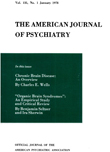ELECTROCARDIOGRAPHY AS A ROUTINE ADMISSION PROCEDURE IN A LARGE NEUROPSYCHIATRIC HOSPITAL: AN EVALUATION
Abstract
The routine use of the electrocardiogram on admission of patients to a large neuropsychiatric hospital has been found to be of considerable value. It has demonstrated a large number of patients (16.6%) to have significant electrocardiographic abnormalities. This has made possible, at a very early stage, the following appropriate measures: 1. Proper treatment of the cardiac, or related, disorder. 2. Rapid evaluation of eligibility for desirable neuropsychiatric therapeutic regime, especially shock therapy. 3. Proper occupational therapy. 4. Realistic rehabilitation planning.
It should further be mentioned that only a small percentage of these patients were suspected of cardiac abnormalities after clinical examination and other laboratory tests.
The procedure of taking routine electrocardiograms on all patients admitted to a neuropsychiatric hospital is highly recommended. [SEE TABLE 1 IN SOURCE PDF]
Access content
To read the fulltext, please use one of the options below to sign in or purchase access.- Personal login
- Institutional Login
- Sign in via OpenAthens
- Register for access
-
Please login/register if you wish to pair your device and check access availability.
Not a subscriber?
PsychiatryOnline subscription options offer access to the DSM-5 library, books, journals, CME, and patient resources. This all-in-one virtual library provides psychiatrists and mental health professionals with key resources for diagnosis, treatment, research, and professional development.
Need more help? PsychiatryOnline Customer Service may be reached by emailing [email protected] or by calling 800-368-5777 (in the U.S.) or 703-907-7322 (outside the U.S.).



